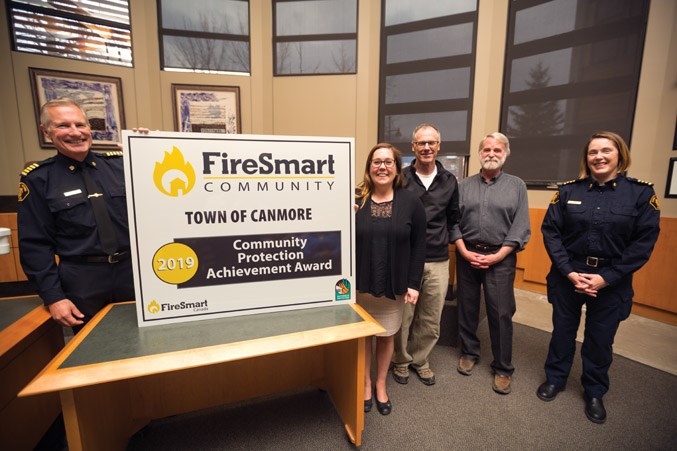CANMORE – The Town of Canmore received a national community protection achievement award from FireSmart Canada for its ongoing efforts to protect the community from the threat of wildfire.
The award was given to the municipality last Wednesday (May 1) during an open house to discuss ways residents can help protect their homes from wildfire.
“We often hear the comment ‘oh, we got lots of good fire trucks we’ll be fine, or forestry will send lots of their tankers and we’ll be OK,’ but there are going to be those days that it doesn’t matter how much iron we have, we’re going to be challenged,” said Stewart Walkinshaw, a FireSmart specialist who works closely with the Town.
He said the best way to reduce the risk of a catastrophic wildfire is by eliminating or reducing combustible material adjacent to residential properties.
“Eighty to 90 per cent of homes destroyed by wildfires are ignited by embers,” said Walkinshaw. “It’s those little embers that are landing on your deck, landing in your firewood pile underneath your deck, or getting into your eaves trough that has dead pine needles in it that are starting a fire on or around your house.”
To help residents protect their homes Canmore Fire-Rescue has begun offering free FireSmart property assessments so residents know how to mitigate the risk.
The Town is also encouraging residents to follow FireSmart Canada’s priority zone map by removing combustible material near their home.
“Eighty-five to 90 per cent of homes with nonflammable roofing materials and 10 metres of clearance in your backyard will survive a major wildfire,” said Walkinshaw. “If homes don’t ignite, homes don’t burn.”
In priority zone 1a, FireSmart Canada suggests homeowners create a 1.5 metre noncombustible radius around their home by clearing vegetation, wooden shrubs and trees.
In zone one, homeowners are encouraged to create a landscape that will not easily transmit fire to their home by planting fire resistant plants and avoiding using mulch within 10 metres of their home.
Residents should also move woodpiles, patio furniture and any construction materials that are against, or near their house, at least 10 metres from their home. Material stored under a deck should also be removed.
In zone two, which is a 10 to 30 metre radius around the home, residents should thin and prune evergreen trees to reduce the fire hazard and selectively remove other trees to create at least three metres of horizontal space between each crown. Branches should also be removed to a height of two metres from the ground.
In zone three, which is a 30 to 100 metres radius around home, FireSmart Canada suggests residents create a firebreak by creating space between trees and other potentially flammable vegetation. Thinning and pruning is effective and will help reduce the intensity of a wildfire.
Walkinshaw said zone two and three are typically municipal or provincial land, so it’s important homeowners focus on removing combustible material within 10 metres of their home.
“If we all work together in creating FireSmart home ignition zones, including the structure and the four zones, I think we’re going to have much more success in the future when wild fires come down the Bow Valley.”
To book a free FireSmart property assessment email [email protected] or call 403-678-6199. Alternatively visit www.firesmartcanada.ca for more information.




